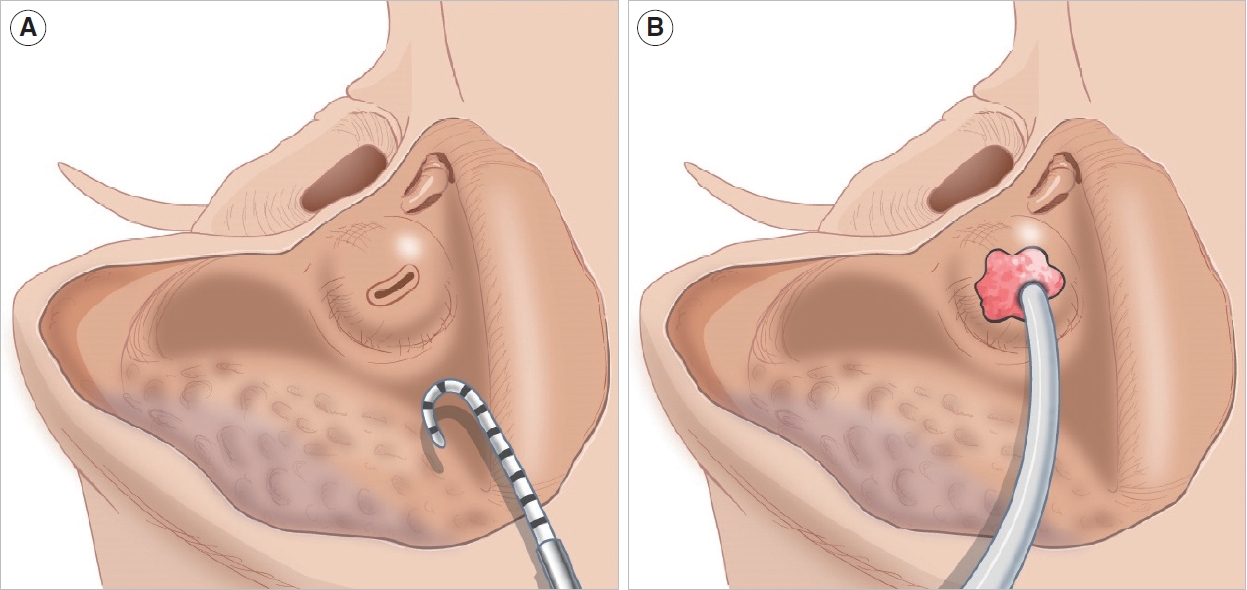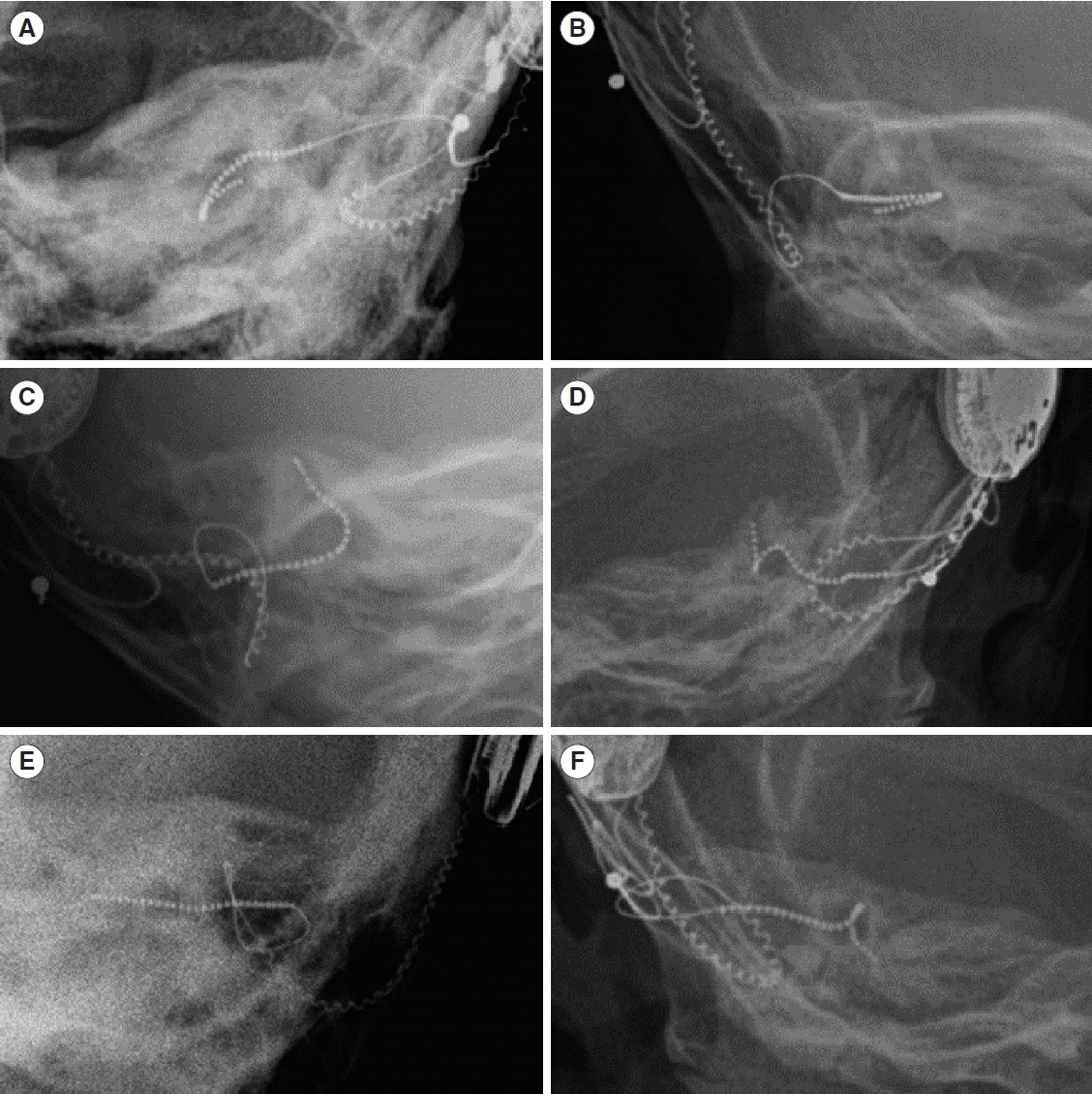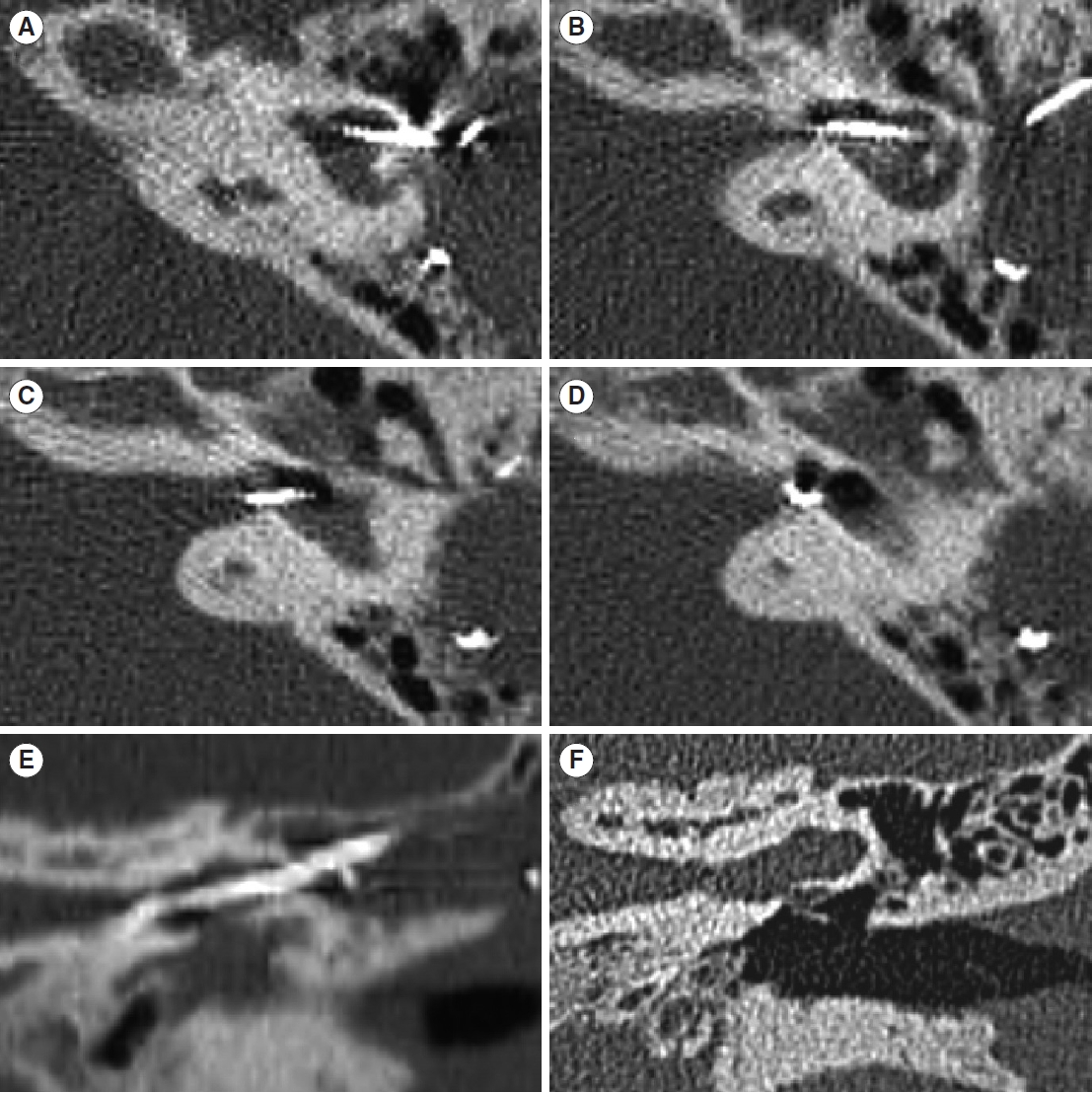Clin Exp Otorhinolaryngol.
2022 Feb;15(1):77-83. 10.21053/ceo.2021.00745.
Cochlear Implants for Patients With Common Cavity Deformities and the Impact of Electrode Positioning
- Affiliations
-
- 1Department of Otorhinolaryngology, Yonsei University College of Medicine, Seoul, Korea
- KMID: 2527115
- DOI: http://doi.org/10.21053/ceo.2021.00745
Abstract
Objectives
. Common cavity deformity is a rare congenital bony labyrinth malformation associated with profound hearing loss. Cochlear implants are widely used for hearing rehabilitation for common cavity deformities; however, the reported prognosis is poor. Due to the deformed anatomical structure, it is important to consider the position of the electrodes to maximize the performance of the cochlear implant. The present study discusses the impact of electrode placement on hearing outcomes.
Methods
. A retrospective medical chart review of eight common cavity deformity patients (10 cochlear implants) who received cochlear implants was performed at a single university hospital. In all eight patients, implant surgery was performed using single-slit labyrinthotomy. Electrodes wer e manually bent before insertion to prevent misplacement and to reduce physical damage to the neuroepithelium.
Results
. Four of the 10 electrodes were misplaced, with their tips placed in the anterior semicircular canal or internal auditory canal. However, after implant surgery, all patients—including those with misplaced electrodes—gained auditory perception and improved hearing function. One patient who had electrodes that did not contact the inner wall of the cavity showed limited activity of the electrodes (27%) compared to others (64%–100%).
Conclusion
. Proper contact of the electrode with the inner wall was more likely to be important for cochlear implant success in cases of common cavity deformity than appropriate placement of the electrode tip.
Figure
Cited by 2 articles
-
How to Maximize the Outcomes of Cochlear Implantation in Common Cavity and Cochlear Aplasia With Dilated Vestibule, the Most Severe Inner Ear Anomalies?
Bong Jik Kim, Byung Yoon Choi
Clin Exp Otorhinolaryngol. 2022;15(1):3-4. doi: 10.21053/ceo.2022.00164.Precision Medicine Approach to Cochlear Implantation
Yehree Kim, Byung Yoon Choi
Clin Exp Otorhinolaryngol. 2022;15(4):299-309. doi: 10.21053/ceo.2022.01382.
Reference
-
1. Brotto D, Avato I, Lovo E, Muraro E, Bovo R, Trevisi P, et al. Epidemiologic, imaging, audiologic, clinical, surgical, and prognostic issues in common cavity deformity: a narrative review. JAMA Otolaryngol Head Neck Surg. 2019; Jan. 145(1):72–8.
Article2. Shi Y, Li Y, Gong Y, Chen B, Chen J. Cochlear implants for patients with inner ear malformation: experience in a cohort of 877 surgeries. Clin Otolaryngol. 2019; Jul. 44(4):702–6.
Article3. Ozkan HB, Cicek Cinar B, Yucel E, Sennaroglu G, Sennaroglu L. Audiological performance in children with inner ear malformations before and after cochlear implantation: a cohort study of 274 patients. Clin Otolaryngol. 2021; Jan. 46(1):154–60.
Article4. Pradhananga RB, Thomas JK, Natarajan K, Kameswaran M. Long term outcome of cochlear implantation in five children with common cavity deformity. Int J Pediatr Otorhinolaryngol. 2015; May. 79(5):685–9.
Article5. Beltrame MA, Birman CS, Cervera Escario J, Kassouma J, Manolidis S, Pringle MB, et al. Common cavity and custom-made electrodes: speech perception and audiological performance of children with common cavity implanted with a custom-made MED-EL electrode. Int J Pediatr Otorhinolaryngol. 2013; Aug. 77(8):1237–43.
Article6. Miyamoto RT, Robbins AJ, Myres WA, Pope ML. Cochlear implantation in the Mondini inner ear malformation. Am J Otol. 1986; Jul. 7(4):258–61.7. Bako P, Nemeth A, Molnar K, Toth T, Harmat K, Rath G, et al. Cochlear implantation in patients afflicted with inner ear malformations: the Pecs experience. Hearing Balance Commun. 2018; 16(4):232–7.8. Sennaroglu L. Cochlear implantation in inner ear malformations: a review article. Cochlear Implants Int. 2010; Mar. 11(1):4–41.9. Xia J, Wang W, Zhang D. Cochlear implantation in 21 patients with common cavity malformation. Acta Otolaryngol. 2015; May. 135(5):459–65.
Article10. Coelho DH, Waltzman SB, Roland JT Jr. Implanting common cavity malformations using intraoperative fluoroscopy. Otol Neurotol. 2008; Oct. 29(7):914–9.
Article11. Ahn JH, Lim HW, Lee KS. Hearing improvement after cochlear implantation in common cavity malformed cochleae: long-term follow-up results. Acta Otolaryngol. 2011; Sep. 131(9):908–13.
Article12. Catli T, Uckan B, Olgun L. Speech and language development after cochlear implantation in children with bony labyrinth malformations: long-term results. Eur Arch Otorhinolaryngol. 2015; Nov. 272(11):3131–6.
Article13. Daneshi A, Farhadi M, Ajalloueyan M, Rajati M, Hashemi SB, Ghasemi MM, et al. Cochlear implantation in children with inner ear malformation: a multicenter study on auditory performance and speech production outcomes. Int J Pediatr Otorhinolaryngol. 2020; May. 132:109901.
Article14. Irvine DR. Auditory perceptual learning and changes in the conceptualization of auditory cortex. Hear Res. 2018; Sep. 366:3–16.
Article15. Zhang L, Qiu J, Qin F, Zhong M, Shah G. Cochlear implantation outcomes in children with common cavity deformity: a retrospective study. J Otol. 2017; Sep. 12(3):138–42.
Article16. Dettman S, Sadeghi-Barzalighi A, Ambett R, Dowell R, Trotter M, Briggs R. Cochlear implants in forty-eight children with cochlear and/or vestibular abnormality. Audiol Neurootol. 2011; 16(4):222–32.
Article17. Loundon N, Rouillon I, Munier N, Marlin S, Roger G, Garabedian EN. Cochlear implantation in children with internal ear malformations. Otol Neurotol. 2005; Jul. 26(4):668–73.
Article18. Bille J, Fink-Jensen V, Ovesen T. Outcome of cochlear implantation in children with cochlear malformations. Eur Arch Otorhinolaryngol. 2015; Mar. 272(3):583–9.
Article19. Beltrame MA, Bonfioli F, Frau GN. Cochlear implant in inner ear malformation: double posterior labyrinthotomy approach to common cavity. Adv Otorhinolaryngol. 2000; 57:113–9.
Article20. Wei X, Li Y, Fu QJ, Gong Y, Chen B, Chen J, et al. Slotted labyrinthotomy approach with customized electrode for patients with common cavity deformity. Laryngoscope. 2018; Feb. 128(2):468–72.
Article
- Full Text Links
- Actions
-
Cited
- CITED
-
- Close
- Share
- Similar articles
-
- Two Cases of Electrode Kinking in Cochlear Implantation
- A Case of Cochlear Implantation in a Child with Common Cavity Inner Ear Malformation
- Recurrent Meningitis in a Patient with Inner Ear Anomaly after Cochlear Implantation
- Clinical Outcomes of Cochlear Reimplantation Due to Device Failure
- Cochlear Implantation Using a Suprameatal Approach in a Case of Severely Contracted Mastoid Cavity





